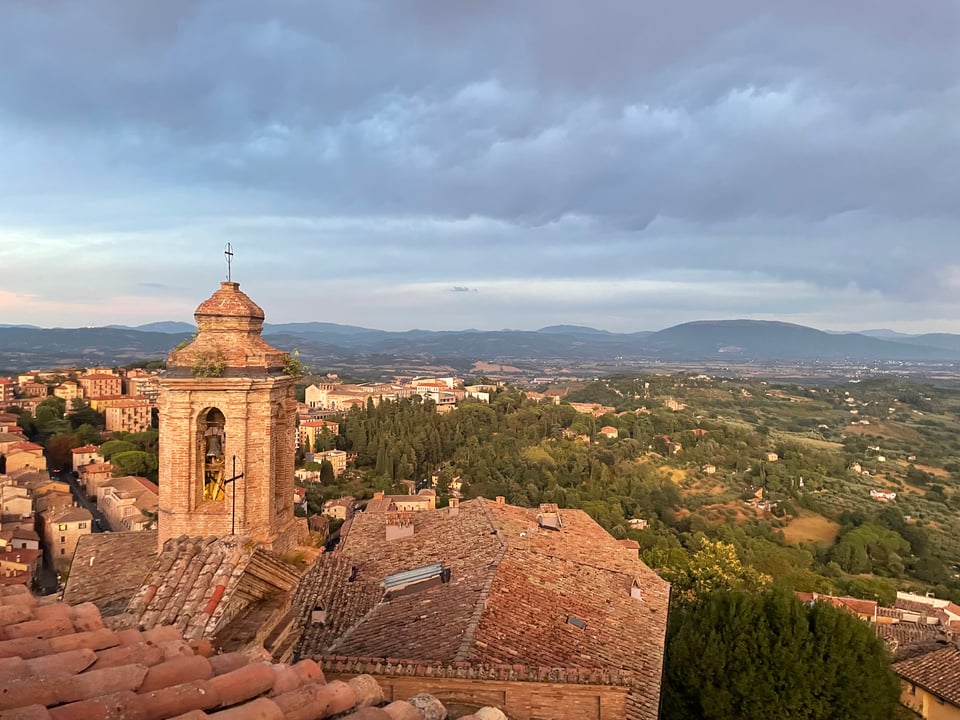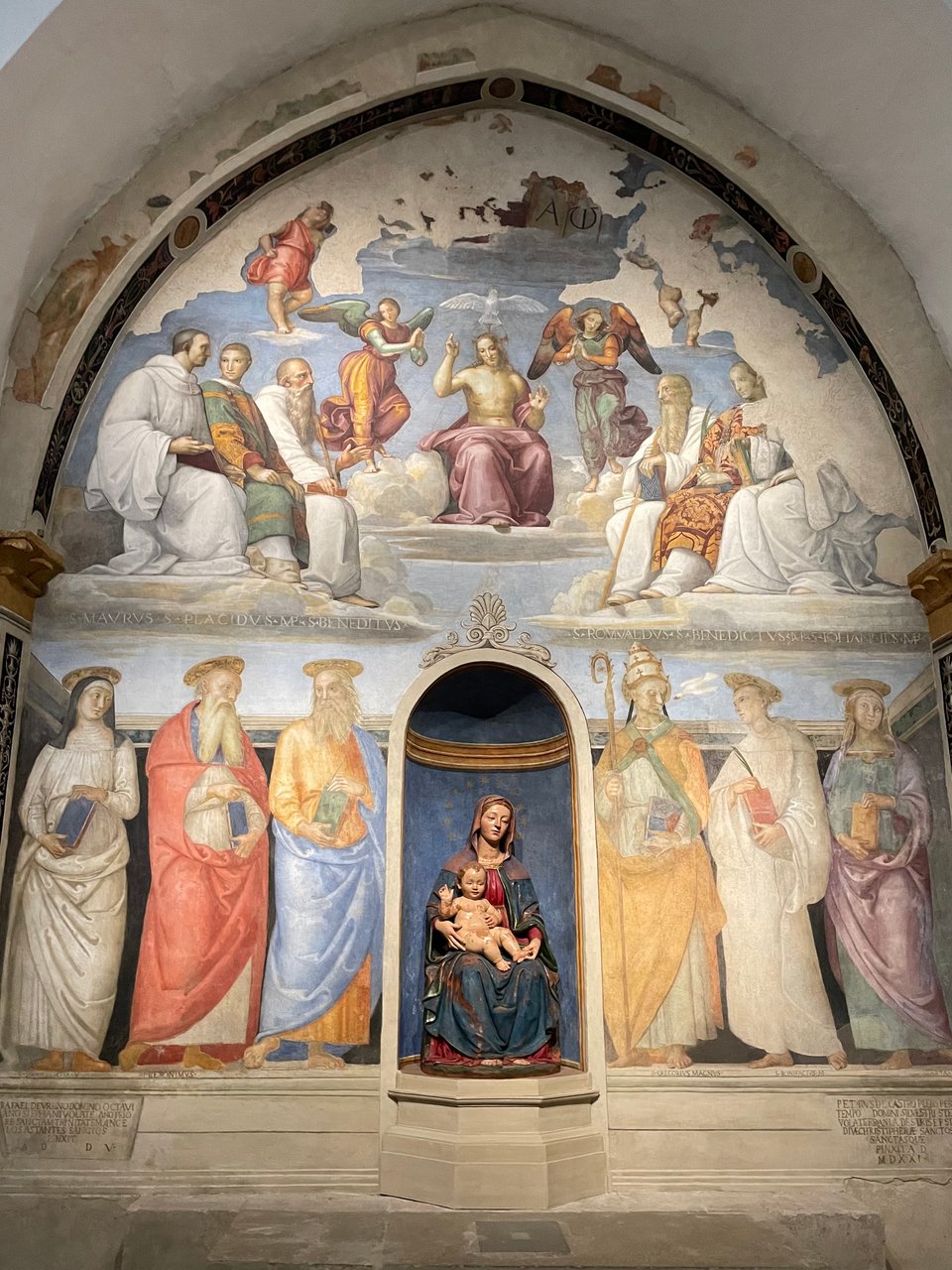Just one thing I saw in 2024 - #3
Looking back at one artwork that made an impact on me in 2024 — a conversation between Perugino and Raphael in Perugia
A modest year in review for a new newsletter

Instead of writing about things I would have written about in 2024 if I had gotten this newsletter going earlier, I’m going to pick just one thing. This year was a bit much, to put it mildly, but as always, I got to plant myself in front of a lot of art, and for that I’m grateful and excited to face the day-to-day of another year. But one thing really landed for me.
In our travels last summer, my big personal discovery was the Umbrian Renaissance painter Perugino. We spent a few days in his hometown of Perugia, where he was born in the middle of the 15th century and went on to learn his craft in Florence and launch a long career moving from job to job around Northern Italy. He is one of those Renaissance masters just below the Teenage Mutant Ninja Turtle level of fame, who made great strides in use of color and form, but still had one foot planted in earlier visual traditions and possibly suffered from working too much and falling into his own stylistic rut.
One of his last works is a fresco at the Cappella di San Severo, in the Porta Sole district of the city. It is on one of those hilltops the city is famous for, with unbelievable views over the Umbrian countryside. It is even mentioned by Dante in Paradiso with a description of how the sun bursts over the landscape at dawn. Perugia is a city of slopes and mazes of medieval streets, where the map on your phone fails to communicate the multidimensional reality of the city and where you get lost trying to find your way from the station at the bottom of the hill. It is one of my favorite places in Italy, still a little off the beaten path and with a robust tourist sector, but nothing like the overwhelmingness of Florence or Venice or I imagine Rome. The Cappella happened to be across the alley from the house where we were staying, and from our window we could look down at the top of its modest cupola where a few saplings grew from the cracks in the bricks.
The Cappella gets a steady stream of visitors because it is the only spot in Perugia with a work by Perugino’s most prominent student. Raphael had already learned all he could from his teacher and was well on his way to immortality when between 1505 and 1508 he returned on a commission for the chapel. He presents a vision of Heaven with his signature brilliant colors (picked up from Perugino, some say) but expressed with a living sense of dynamic motion. The image is of the Trinity, with Christ and his wounds at the center beneath the dove of the Holy Spirit, though the representation of the Father is lost. Just below chilling on some clouds are an assortment of saints special to the Camaldolesian monks that commissioned the work.

Raphael left the assignment unfinished when he was called away to some big gigs in Rome and died a too early death at 37 in 1520. The monks called in his teacher to finish the work, even though he was in his 70s. The result is a case of time flowing backward — the master of an earlier layer of the Renaissance filling out a job left by the pupil who eclipsed him. He grounds the work in something steady and brilliant with full-length portraits of six saints. They are almost medieval in how they are placed – standing static in their designated nooks beneath Raphael’s soaring extravagance. It was already deeply out of fashion at the time, but you can feel the effort to make them express their singular personalities bursting through. Each is a whole person, a tired and well-scrubbed Saint Jerome, a tortured Saint Boniface. The most beguiling is Saint Marta on the bottom right, the sister of Lazarus who is the sacred embodiment of common sense and care for others, shown with a simple, common prettiness which Perugino’s detractors dismissed as shallow for centuries after.


You can dive into the individual elements of the fresco but the whole thing takes off when you stand before it. You look up at the divine image over your head, forced to physically adjust your body to meet the scene. At the same time those saints seem to stand right beside you. It is a feeling of soaring and grounding at the same time.

The great joy of travel is to put yourself in a place to experience a new thing with all your senses and your body, to just plant yourself and take note. Picking up the effects of light and sound and the air around you, seeing who comes and goes. I spent a while there as a regular troop of visitors came along — young parents with toddlers and strollers (a great many from France for some reason), a few dutiful tour groups marching in and out and getting chattered at by their guides. My own group of friends were sharing the moment, but this was our first stop, and we had a long list of things to see. My daughter was chattering about what she learned online about a notorious murder that happened just a few blocks away.
Like many of us I feel like I spent most of 2024 thinking about something other than what was in front of me. Setting aside the overall condition of the world we face, a lot of it is the push-pull dynamic of my specific phase of life. Worry about aging parents, children getting ready to leave home and start out on their own, uncertainty of whether the back and knees will hold up for the rest of the day, let alone the coming year. Each moment arrives and leaves with severe and merciless precision, and it’s just enough to hang on even as everything keeps going.
Thanks for reading so far, and I look forward to seeing what lies ahead! Have a safe and happy new year!